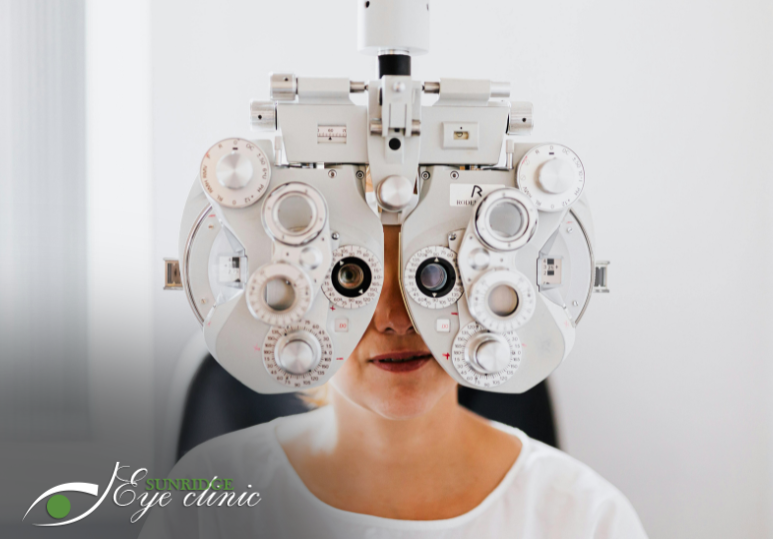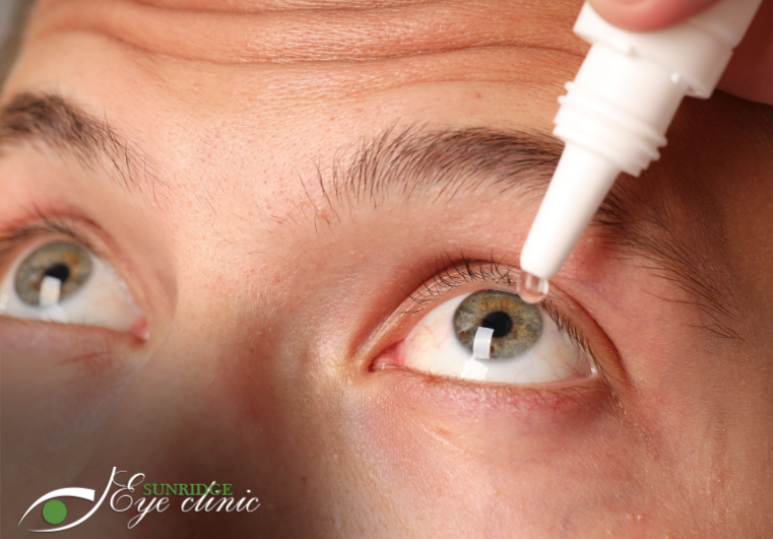Age-Related Macular Degeneration (AMD) is a common eye condition that typically comes on gradually as we age. There are two different types of AMD, wet and dry, which bring about two different sets of symptoms and treatment options.
If you, or someone you care about, are experiencing blurred and distorted vision, or perhaps noticing a sudden or gradual loss of vision, these can be signs and symptoms of Macular Degeneration. AMD can be detected through a thorough eye exam with our trusted Optometrists at Sunridge Eye Clinic.
What is Macular Degeneration (AMD)?
Macular Degeneration is an eye disease that can cause partial, or full, vision loss over time. It’s believed that the cause of AMD aging, but there have been some identifying factors that are closely associated with an increased risk of developing this condition such as:
- Family History: If AMD runs in your family, your chances of developing it yourself increase substantially.
- Obesity: Some studies have shown a link between AMD and an above-average body fat percentage.
- Smoking: Smokers are 75% more likely to develop Macular Degeneration than non-smokers.
- Diet: Foods high in saturated fats, three or more alcoholic beverages a day, and consumption of refined sugars are linked with developing Age-Related Macular Degeneration.
- Gender and Ethnicity: Statistics show that women are more likely to develop AMD than men. Caucasian people are the most likely to develop symptoms of Macular Degeneration followed by Chinese and Hispanic people.
- Blood Pressure: Much like smoking, having high blood pressure decreases the amount of oxygen in your bloodstream which has been linked to the development of this disease.
Whether, or not you have any increased risk factors of AMD, you can still develop symptoms of Macular Degeneration. There are two types of AMD: Dry and Wet which both present themselves in different ways.
- Dry Macular Degeneration: This is the most common type of Age-Related Macular Degeneration, affecting about 80% of those who get the eye condition. Dry AMD occurs when yellow deposits, called drusen, accumulate in your macula (near your retina). This may cause your eyes to dim and/or distort your vision. As you age, the cells in the centre of your eye begin to die, causing blurred vision, and possibly the loss of the central part of your vision entirely.
- Wet Macular Degeneration: If you are one of the people who develops symptoms of wet AMD this is caused by blood vessels leaking into your retina. This fluid causes distortion in your vision and the development of blind spots in the central part of your vision.
If you suspect any symptoms of Macular Degeneration, or any other eye conditions, reach out to your Calgary Optometrist for an eye examination right away. When degenerative eye diseases are caught early there are treatment options that can help preserve and protect the health of your eyes.
How To Treat Age-Related Macular Degeneration
Of course, taking any preventative measures to avoid the development of Macular Degeneration is a great first step. You are never too old, or too young, to partake in a healthy, active lifestyle. Some of the preventative measures you can integrate into your life are a healthy diet and exercise routine. Adding dark leafy greens, yellow fruits, lots of water and regular moderate exercise are all great ways to stay healthy, in general, and to lower the risk factors associated with AMD.
Currently, there is no way to treat dry AMD, but there have been studies that report an improvement in vision impairment through certain vitamins and mineral supplementation. Patients taking a combination of Vitamin C, E, Lutein, Zeaxanthin, Zinc, and Copper, as directed by their Optometrist, have shown to slow the progression of their Dry Macular Degeneration symptoms.
Wet AMD can be treated through a combination of medication and/or laser surgery to slow the leaking of the blood vessels, therefore decrease the fluid buildup in the retina. Some of the laser surgeries that may be recommended are high-energy laser light or photodynamic laser therapy.
Living with Macular Degeneration
If you have been diagnosed with Macular Degeneration you can make the most of your remaining vision by making healthy lifestyle choices, using treatment options as recommended by your professional eye care team, and the use of low vision tools to help you see the best you can.
Some low vision aid options are magnifying lenses to see smaller items closer up, reading stand magnifiers to make reading easier, high-tech options such as a tablet device, and a visual rehabilitation team to make recommendations and other therapeutic options.
Life with a chronic, progressive eye condition doesn’t have to be a life sentence. Take control of your ocular health but booking in for regular eye exams, and by keeping closely connected with the Calgary Macular Degeneration specialists at Sunridge Eye Clinic.
Frequently Asked Questions
Can younger people get Macular Degeneration?
Juvenile Macular Degeneration (JMD) is a term for a group of rare eye diseases that can affect young children.
What age does Macular Degeneration start?
Typically, AMD begins around the age of 50, give or take. It is the leading cause of vision loss for people over the age of 60.
What are some early signs of Macular Degeneration?
Some early symptoms of AMD are:
- Blurred vision, especially in the middle of your sight
- Straight lines appearing wavy and distorted
- Objects looking ‘fuzzy’
- Increased sensitivity to glaring light





